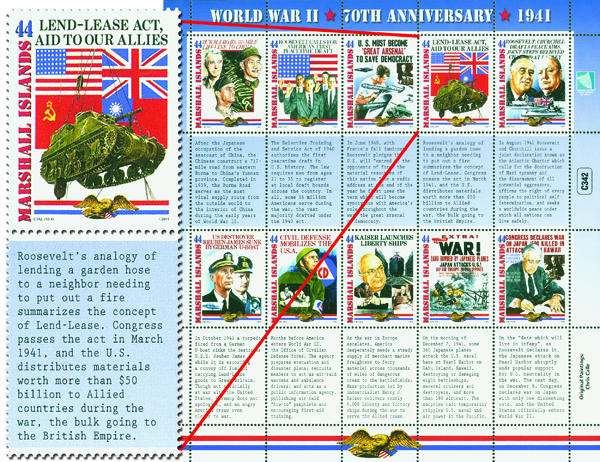Roosevelt Signs Lend-Lease Act
Roosevelt Signs Lend-Lease Act

On March 11, 1941, Franklin Roosevelt signed the Lend-Lease Act to provide aid to Allied forces in World War II.
At the end of 1940, Nazi Germany was marching through Europe. The British and the Commonwealth were boldly fighting alone against the powerful enemy, but their military supplies were running low. They had been paying for their supplies in gold as required by the U.S. Neutrality Acts of the 1930s, but soon ran low on funds.

While the U.S. was resolved to remain neutral, the government also began preparing for war, instituting the first peacetime draft and increasing the defense budget to $10 billion. British Prime Minister Winston Churchill began pressing President Franklin D. Roosevelt for help.
Roosevelt knew America could help, but was hindered by the Neutrality Acts. He also had to get American citizens to support such a plan. On December 29, he gave a radio broadcast in which he referred to the United States as “the great arsenal of democracy,” because he knew the automobile factories could be converted to produce the supplies that Britain needed. The U.S. was not willing to go to war in Europe at that time, but through the President’s urging, would help its allies defeat the enemy. As one of Roosevelt’s biographers put it, “Britain and the Commonwealth were carrying the battle for all civilization, and the overwhelming majority of Americans, led in the late election by their President, wished to help them.”

The Lend-Lease Act – also known as “An Act to Promote the Defense of the United States” – was signed into law on March 11, 1941. It put the “arsenal of democracy” that President Roosevelt had introduced a few months before into action. The agreement allowed America to loan supplies until they were either no longer needed or destroyed. The U.S. loaned tanks, trains, planes, and trucks to our allies: the Soviet Union, China, France, and the United Kingdom. The “Liberty Ships” that carried cargo across the sea were produced for Britain before the U.S. entered the war. They were mass-produced in factories, and many women worked on assembly lines for the first time. The U.S. also supplied much-needed rations and clothing to the soldiers in Europe.
The act wasn’t without its critics. Senator Robert Taft, for instance, claimed that the bill would “give the President power to carry on a kind of undeclared war all over the world, in which America would do everything except actually put soldiers in the front-line trenches where the fighting is.”

As stipulated in the act, once the U.S. officially joined the war, it received leases to use army and navy bases in Allied territory. Over the course of the war, the U.S. provided $50.1 billion worth of supplies. This totaled about 17 percent of the nation’s total war expenditures. After the war, supplies that hadn’t been destroyed were either returned to the U.S. or purchased by the borrowing nation at a deep discount.
Click the images to add this history to your collection.
Great info. I was not aware of this historical incident.
That’s exactly how it should be….Freedom’s just another 50 Billion in Bullion. Countries who can afford our help get our help. We’ll take in trade or dollars. This is a great article about what a true inspirational leader has done, and a positive model for future leadership heads.
The unfortunate and often ignored part of this story is that FDR had a very difficult time getting Congress to understand just how dangerous s time it was, especially for the British who for a time stood alone against the Nazis. The outcome of the war was not at all certain for at least two years
Victory was just not a foregone conclusion. The isolationists in Congress played their favorite game of obstructionism.
The Soviet Union received billions on dollars worth of US equipment and never paid a dime for it or even thanked is for it.
Super informing … and FDR proved himself to be a great U.S.President.